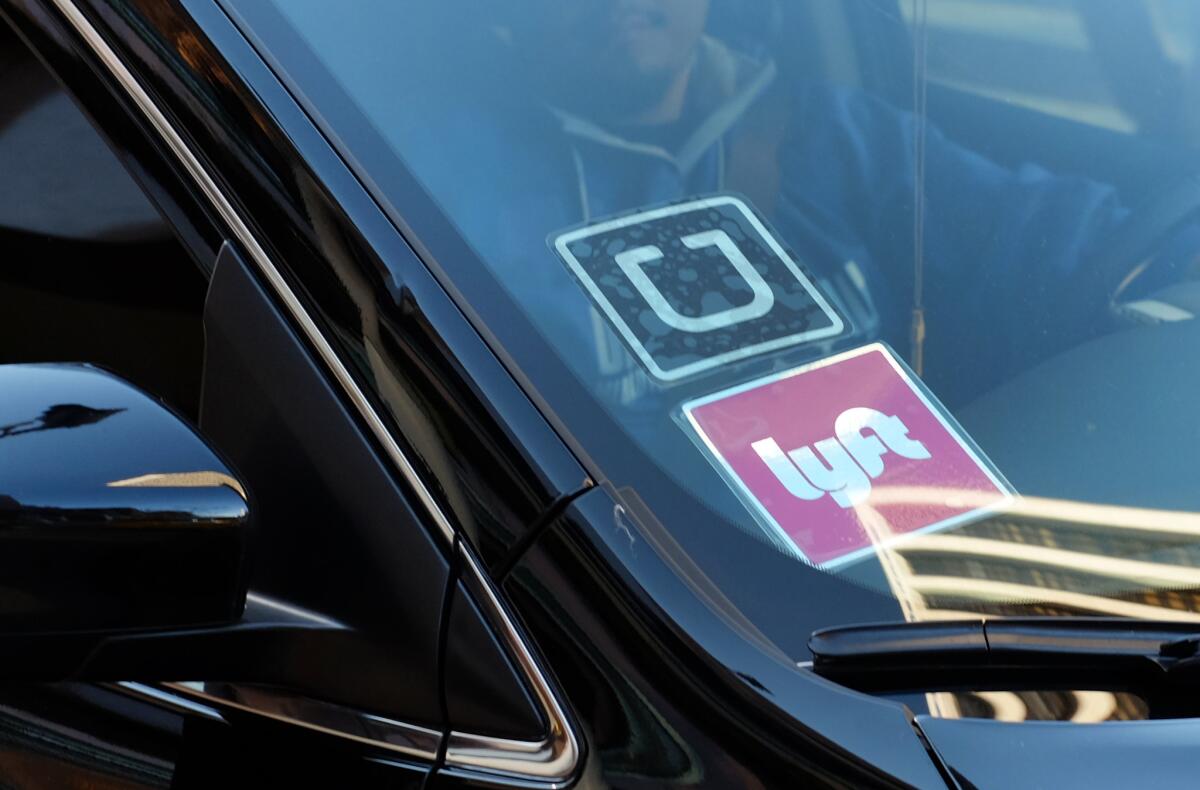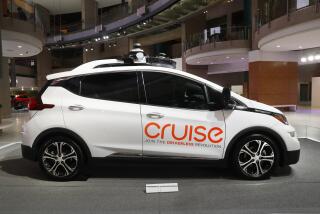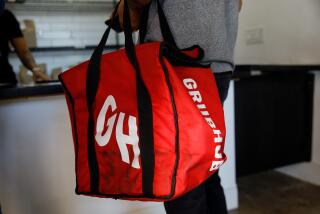Dumpling is a new alternative for Uber and Lyft drivers

- Share via
Uber and Lyft are the undisputed leaders in the ride-hailing space. But with a regulatory dispute potentially forcing them to change their business practices or flee California — a potential harbinger of things to come — a ride-hail upstart has launched to give drivers an alternative.
A company called Dumpling, which also operates in the grocery shopping space, has launched a ride-hail application, Dumpling Drive, that aims to enable Uber and Lyft drivers to go into business for themselves. Instead of taking a share of every ride, the site charges drivers a monthly fee. There is also a 3% credit card charge; drivers keep the remaining 97%.
“With everything that was going on in California, we wanted to give Uber and Lyft drivers an alternative,” said Joel Shapiro, co-chief executive of Dumpling. “This is a decidedly different experience for both the rider and the driver.”
Aside from helping ride-hail drivers track and bill for their work, Dumpling is little like Uber and Lyft. This app is more of a complement to Uber and Lyft than a competitor. That’s mainly because Dumpling doesn’t send riders to drivers; it simply helps them price and bill for rides they arrange on their own. Thus, the best way for you to launch your Dumpling Drive business is to work for other ride-hail companies at the same time.
How it works
To understand how it works, let’s first look at how Uber and Lyft operate. With those companies, drivers sign up, get approved and then flip on their apps when they want to make themselves available to provide a ride.
The only decision the driver makes is whether to take a fare. Everything else — finding the rider, connecting the driver and determining both the price the rider pays and how much of the fare is passed along to the driver — is determined by the ride-hail company. Once any given ride is completed, the driver and rider part ways and most likely never see each other again.
Dumpling, on the other hand, leaves nearly everything in the hands of the driver, including finding the clients and determining pricing. When drivers sign on with this app, the program asks them to set their rates, including minimum, per-mile and per-minute charges.
When a rider wants to book a trip, he or she plugs in the start and end points and the timing of the ride. The app estimates the cost based on historical traffic patterns and the driver’s preferences. The driver can accept, reject or ask to alter the booking.
Setting rates
Let’s say you’re a driver who wants to earn $30 per hour, after expenses. You might set your rates at 50 cents per minute, plus 58 cents per mile. (The Internal Revenue Service estimates the cost of each business mile at 57.5 cents, given the average cost of gas, depreciation, insurance, repairs, etc.) You can also set a minimum rate for each ride, such as $5 or $10, so you don’t have to bother with unprofitable short trips.
What happens when someone wants to book you to drive them to the airport 30 miles away? The app plugs in your required mileage cost of $17.40 (at 58 cents per mile). It also estimates the drive time based on how long it would typically take to get to that destination at that time of day, given historical traffic patterns. If that drive would typically take 45 minutes, the app will add a per-minute charge of $22.50. The final cost to the rider: $39.90, which is competitive with the cost of booking the same airport trip with Uber or Lyft.
However, the Dumpling driver is not splitting that fare with a ride-hail company. Outside of the 3% credit card processing fee, the entire cost of the ride — plus any tip — goes directly to the driver. That nets the Dumpling driver $38.70 before any tip.
What would the driver take home with Uber? Given that company’s formula in Los Angeles, the same ride would pay an Uber driver $27.45 before tip — about 30% less.
Dumpling does charge a $20 monthly subscription fee. Still, if you book 10 rides per month through this app, that works out to a cost of $2 per ride — a fraction of what you’d pay to Uber or Lyft. The site is also giving drivers a two-month free trial, so there’s no cost to try out the service.
Finding clients
Dumpling’s main shortcoming is that it doesn’t arrange on-demand rides and doesn’t find customers for you. (If you drop off a customer at the airport, Dumpling — unlike Uber and Lyft — won’t connect you with a rider in the same place who wants to be picked up.) While theoretically one of your regular customers could ping you if they found themselves stranded somewhere, the app is focused on rides that are planned in advance. More important, you must find your own clients.
That’s one reason it makes sense to use Dumpling Drive as a supplement to Uber and Lyft rather than as a replacement. If you happen to hit it off with a Lyft rider, for instance, you can hand that person your Dumpling business card at the end of the ride and suggest that they call you whenever they want to schedule a trip in advance.
And, of course, you can flip on your Uber or Lyft apps when you’ve completed a Dumpling ride, so you can get on-demand work to fill your unscheduled time.
A ride-hail driver in Baton Rouge, La., says he has used this strategy to build his Dumpling business to about $1,000 in regular rides each month. He still depends on Uber and Lyft for the bulk of his income. But Dumpling is becoming a growing percentage of his business.
Marketing yourself
Finding your own clients requires marketing your services — unfamiliar territory for many drivers. However, this gives each driver the ability to specialize in the type of rides they like best.
If, for instance, you like driving people to the airport, you might talk to travel agents in your neighborhood. Drop off business cards and ask that they recommend you to their clients. Likewise, those who want to specialize in driving elderly clients might market through senior centers. You can target business groups through a local Chamber of Commerce and target parents through local PTA organizations.
Advantage for regulars
Although finding your own clients may be a challenge, it can be an advantage. Uber and Lyft drivers often complain about inconsiderate riders spilling drinks in their cars or hopping in without wearing masks. They also tell horror stories about drunk partiers passing out — or tossing up — in their vehicles.
When you build your own clientele, you can simply deny rides to customers who don’t follow your rules, while encouraging the customers you like to book with you. After all, you’re in charge here — if you want to give your favorite riders a discount, that’s completely up to you.
Kristof is the editor of SideHusl.com, an independent site that reviews hundreds of money-making opportunities in the gig economy.
More to Read
Inside the business of entertainment
The Wide Shot brings you news, analysis and insights on everything from streaming wars to production — and what it all means for the future.
You may occasionally receive promotional content from the Los Angeles Times.










